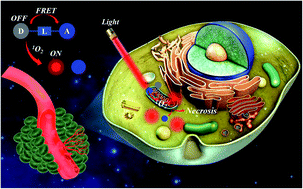A singlet oxygen self-reporting photosensitizer for cancer phototherapy†
Abstract
Photodynamic cancer therapy has attracted great attention with the increasing threat of tumors, and improving its therapeutic efficacy is highly desirable. However, due to the highly efficient intersystem crossing potency to generate singlet oxygen (1O2), high-efficiency photosensitizers often suffer from weak fluorescence and excess injury to normal tissue. To overcome these obstacles, here we show a reliable self-reporting strategy for real-time monitoring of therapeutic progression. As a proof of concept, a molecular dyad is designed by connecting benzo[a]phenoselenazinium (NBSe) to rhodamine (Rh), namely Rh-NBSe, where the fluorescence of the Rh unit is initially suppressed by the fluorescence resonance energy transfer mechanism, but enabled to recover as feedback signal once the reaction with photosensitized 1O2 takes place. The observed fluorescence increases by irradiation in vitro and in vivo successfully reflect the real-time 1O2 generation speed in photodynamic therapy. In addition, the favorable therapeutic advantages of Rh-NBSe are also verified, for example, the high ΦΔ (0.8) and the low IC50 (0.2 μM, 6 J cm−2). Based on the therapeutic ability and real-time 1O2 self-reporting ability, Rh-NBSe demonstrates significant potential for self-regulating phototherapy.

- This article is part of the themed collection: Editor’s Choice – Jinlong Gong


 Please wait while we load your content...
Please wait while we load your content...